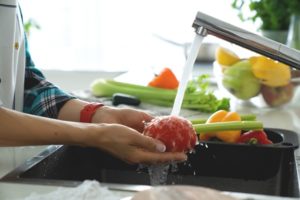
The Basic Rule
I am not an infectious disease expert. However, my years of experience working in healthcare and in food handling/safety situations reminds me that following the basic guidelines of self-care and food safety are the best ways to prevent infections, especially in the current situation. Read any article, tweet or post about COVID-19 and the final word of caution is “wash your hands!” It sounds easy but how many times do you actually wash your hands during the day, especially when preparing or eating food? We’ve all heard that we need to wash our hands with soap and water for 20 seconds (the equivalent of two verses of “Happy Birthday”) for best results. So how many verses do you sing in a day’s time? Apparently, more of us are taking the 20 second rule to heart as alternative songs like “This Land is Your Land” are being suggested on Twitter, but are we washing our hands enough?
Think about your daily routine, especially when you travel and dine out. Those of us with farm backgrounds often say “a little dirt won’t hurt you” but in reality we need to use common sense. Here are the basic guidelines of when we should wash our hands:
In the Kitchen:
* After you prepare or handle raw foods such as poultry or other meats and seafood
* Between food preparation tasks involving raw meats and vegetables
* After you handle egg products
* Before and after answering the phone during food preparations
During Your Daily Routine Before You:
* Handle, prepare or eat food (at home or restaurants)
* Feed children or the elderly
* Eat lunch at your desk or a food truck
During Your Daily Routine After You:
* Use your cell phone, computer or other handheld device
* Use the restroom
* Handle garbage or dirty dishes
* Cough or sneeze
* Touch animals or other people
* Touch your hair, body or any open cuts or sores
Beyond the Hands: The Kitchen Zone
While washing hands is the first step in the line of defense of spreading germs, keeping a clean and safe kitchen is close behind. The standard principles of clean, separate, cook and chill are the foundation in preventing food-borne illness but also will reduce the spread of viruses and germs.
Regardless of the time you spend in the kitchen actually cooking, for many (like us), it’s a livable space and a direct entry to the house. So, keeping countertops and tables in the “clean zone” is not easy, especially if the area is also used for mail storage and a landing place for grocery bags.

- Remove non-cooking essentials from counter-tops
- Don’t put grocery bags on countertops
- Clean countertops and sinks before any meal preparation with hot, soapy water and clean cloth or paper towels
- Sanitize using a prepared solution or mix a solution of one tablespoon of unscented liquid chlorine bleach to one gallon of water. Do not overuse bleach. “More is not better” and can actually be toxic.
When preparing food, always clean the tops of any canned food before opening and wash fresh produce under water, even if the skin is inedible. Even though the current COVID-19 virus is not spread through food, food-borne illness can still occur if basic “rules” are not given serious attention.
A Safe Food Supply
Food safety is always top priority for all suppliers. FMI, the food industry association that works with and on behalf of the entire industry to advance a safer consumer food supply chain, has produced a guide to ensure consumers are guaranteed a safe food supply during any potential outbreaks. “Coronavirus and Pandemic Preparedness for the Food Industry” is available for download from FMI.
As stated by FMI, “while there are still many unknowns with the 2019 novel coronavirus and how it spreads, it is believed that the new coronavirus behaves similarly to other coronaviruses (i.e., SARS and MERS) and thus has poor survivability on surfaces and packages. Therefore, products and packages shipped to the U.S. from China pose a very low risk of spreading the virus.” However, FMI does encourage grocery retailers to “evaluate all suppliers, ensure that they have strong food safety programs in place and are meeting all food safety specifications that have been established.”
It’s in Our Hands
We always say food safety and halting food-borne illness is in our hands (literally) and this situation is no exception. Let’s all do our part. Be sensible, be smart and wash your hands.
Resources:
1. Roberta L. Duyff, MS, RDN, FAND Academy of Nutrition and Dietetics, Complete Food & Nutrition Guide, 2017. (Available on Amazon)
4. FMI, Coronavirus Resources and Preparedness Checklist
5. FMI, Coronavirus and Pandemic Preparedness for the Food Industry
